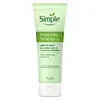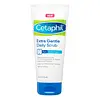What's inside
What's inside
 Key Ingredients
Key Ingredients

 Benefits
Benefits

 Concerns
Concerns

 Ingredients Side-by-side
Ingredients Side-by-side

Water
Skin ConditioningParaffinum Liquidum
EmollientCoco-Glucoside
CleansingHydrated Silica
AbrasiveOryza Sativa Germ Powder
AbrasiveVegetable Oil
Skin ConditioningAcrylates Copolymer
Acrylates/C10-30 Alkyl Acrylate Crosspolymer
Emulsion StabilisingDisodium EDTA
Hydroxypropyl Cyclodextrin
MaskingIodopropynyl Butylcarbamate
PreservativePanthenol
Skin ConditioningPantolactone
HumectantPhenoxyethanol
PreservativeSodium Hydroxide
BufferingTocopheryl Acetate
AntioxidantWater, Paraffinum Liquidum, Coco-Glucoside, Hydrated Silica, Oryza Sativa Germ Powder, Vegetable Oil, Acrylates Copolymer, Acrylates/C10-30 Alkyl Acrylate Crosspolymer, Disodium EDTA, Hydroxypropyl Cyclodextrin, Iodopropynyl Butylcarbamate, Panthenol, Pantolactone, Phenoxyethanol, Sodium Hydroxide, Tocopheryl Acetate
Water
Skin ConditioningCocamidopropyl Betaine
CleansingDisodium Cocoamphodiacetate
CleansingCoco-Glucoside
CleansingSodium Cocoamphoacetate
CleansingGlycerin
HumectantPanthenol
Skin ConditioningTocopheryl Acetate
AntioxidantBambusa Arundinacea Stem Extract
Skin ConditioningSodium Hydroxide
BufferingSodium Benzoate
MaskingSodium Citrate
BufferingXanthan Gum
EmulsifyingHeliotropine
MaskingPhenoxyethanol
PreservativePolyquaternium-10
Acrylates/C10-30 Alkyl Acrylate Crosspolymer
Emulsion StabilisingCitric Acid
BufferingParfum
MaskingWater, Cocamidopropyl Betaine, Disodium Cocoamphodiacetate, Coco-Glucoside, Sodium Cocoamphoacetate, Glycerin, Panthenol, Tocopheryl Acetate, Bambusa Arundinacea Stem Extract, Sodium Hydroxide, Sodium Benzoate, Sodium Citrate, Xanthan Gum, Heliotropine, Phenoxyethanol, Polyquaternium-10, Acrylates/C10-30 Alkyl Acrylate Crosspolymer, Citric Acid, Parfum
Ingredients Explained
These ingredients are found in both products.
Ingredients higher up in an ingredient list are typically present in a larger amount.
Acrylates/C10-30 Alkyl Acrylate Crosspolymer is a synthetic polymer. It is used to thicken and improve the texture of products. Due to its properties, it can prevent water and oil ingredients from separating.
Coco-Glucoside is a surfactant, or a cleansing ingredient. It is made from glucose and coconut oil.
Surfactants help gather dirt, oil, and other pollutants from your skin to be rinsed away.
This ingredient is considered gentle and non-comedogenic. However, it may still be irritating for some.
Learn more about Coco-GlucosidePanthenol is a common ingredient that helps hydrate and soothe the skin. It is found naturally in our skin and hair.
There are two forms of panthenol: D and L.
D-panthenol is also known as dexpanthenol. Most cosmetics use dexpanthenol or a mixture of D and L-panthenol.
Panthenol is famous due to its ability to go deeper into the skin's layers. Using this ingredient has numerous pros (and no cons):
Like hyaluronic acid, panthenol is a humectant. Humectants are able to bind and hold large amounts of water to keep skin hydrated.
This ingredient works well for wound healing. It works by increasing tissue in the wound and helps close open wounds.
Once oxidized, panthenol converts to pantothenic acid. Panthothenic acid is found in all living cells.
This ingredient is also referred to as pro-vitamin B5.
Learn more about PanthenolPhenoxyethanol is a preservative that has germicide, antimicrobial, and aromatic properties. Studies show that phenoxyethanol can prevent microbial growth. By itself, it has a scent that is similar to that of a rose.
It's often used in formulations along with Caprylyl Glycol to preserve the shelf life of products.
Sodium Hydroxide is also known as lye or caustic soda. It is used to adjust the pH of products; many ingredients require a specific pH to be effective.
In small amounts, sodium hydroxide is considered safe to use. However, large amounts may cause chemical burns due to its high alkaline.
Your skin has a natural pH and acid mantle. This acid mantle helps prevent harmful bacteria from breaking through. The acid mantle also helps keep your skin hydrated.
"Alkaline" refers to a high pH level. A low pH level would be considered acidic.
Learn more about Sodium HydroxideTocopheryl Acetate is AKA Vitamin E. It is an antioxidant and protects your skin from free radicals. Free radicals damage the skin by breaking down collagen.
One study found using Tocopheryl Acetate with Vitamin C decreased the number of sunburned cells.
Tocopheryl Acetate is commonly found in both skincare and dietary supplements.
Learn more about Tocopheryl AcetateWater. It's the most common cosmetic ingredient of all. You'll usually see it at the top of ingredient lists, meaning that it makes up the largest part of the product.
So why is it so popular? Water most often acts as a solvent - this means that it helps dissolve other ingredients into the formulation.
You'll also recognize water as that liquid we all need to stay alive. If you see this, drink a glass of water. Stay hydrated!
Learn more about Water